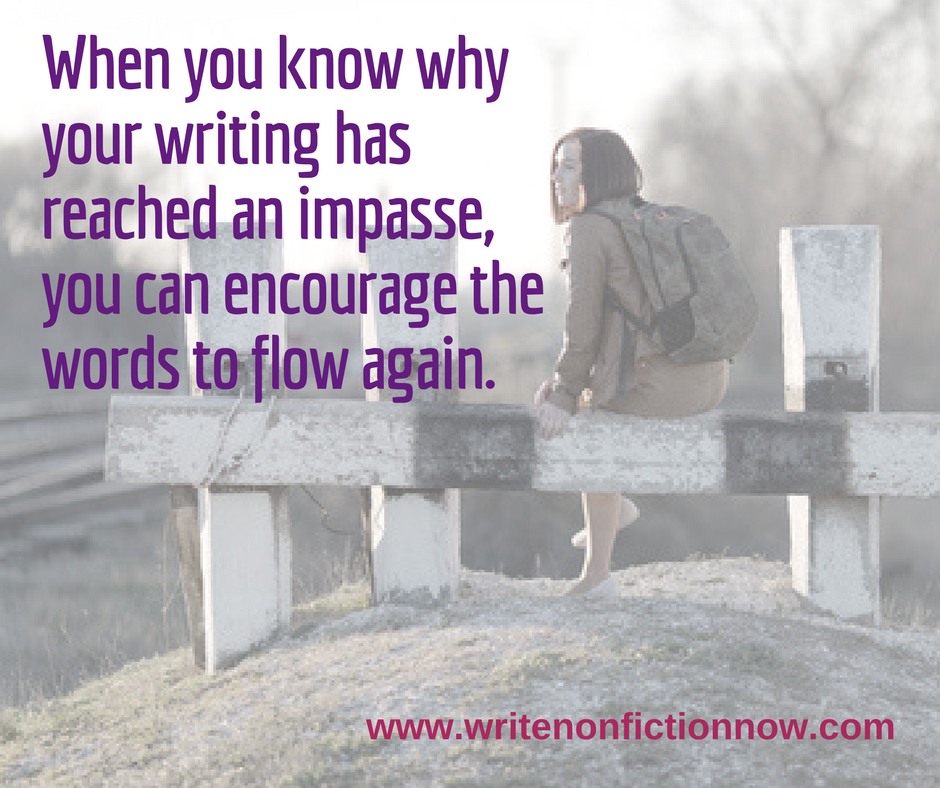Sometimes, even after the most immersive writing experiences, you may still reach an impasse in your writing. What do you do then to keep the words flowing? Discover what’s at the root of the writing impasse.
Let’s examine a few strategies that will help keep the words flowing as you gain clarity on what’s causing the obstacle.
Courting Inspiration
Inspiration for your subject matter needs to remain high throughout the writing process. If you feel blocked and can’t get the creative juice flowing, maybe you lack inspiration.
Julia Goldberg in her book, Inside Story: Everyone’s Guide to Reporting and Writing Creative Nonfiction says, “Spending time thinking about writing, reading as much as possible, and courting inspiration are all part of the [writing practice] amalgam. Part of courting inspiration is learning what makes you excited to write.”
Courting inspiration can come in many different forms: reading books and magazines about writing, attending an online or in-person writing workshop, and talking with writer friends about works in-progress. And when all else fails, the best remedy might be
taking an inventory.
Ask yourself:
- What’s missing from my writing process?
- Do I need to go back and do more research?
- Do I need to literally and figuratively wander in the place, time and location of my story?
- What will regenerate my interest and excitement?
When you’re really stuck, you can try telling your story to someone else. As Susan Orlean suggests, “Listen to the scenes you tell with passion.” Notice where you feel excited. Notice if your friend is captivated by your story or if they look bored. Ask for an honest critique.
Taking a Draft Inventory: Specifics, Voice, and Time
When the words don’t come, it might be time to behave more like a researcher than a writer. In the process, gain perspective and specifics that help you get in the flow again.
In author Ted Conover’s book, Immersion: A Writer’s Guide to Going Deep, he describes the value of taking an ethnographic perspective when doing research for nonfiction books. Ethnography is defined as “the systematic study of people and cultures. It is designed to explore cultural phenomena where the researcher observes society from the point of view of the subject of the study.”
When Conover was travelling to do research for his book, Rolling Nowhere: Riding the Rails with America’s Hoboes, his observations and analyses were guided by James Spradley’s framework for participant observation. Spradley suggests that for a reader to see the lives of the people we study, “we must show them through particulars, not merely talk about them in generalities.” Spradley’s model addresses nine dimensions:
- Space – layout of the physical setting; rooms, outdoor spaces, etc.
- Actors – the names and relevant details of the people involved
- Activities – the various activities of the actors
- Objects – physical elements: furniture etc.
- Acts – specific individual actions
- Events – particular occasions, e.g. meetings
- Time – the sequence of events
- Goals – what actors are attempting to accomplish
- Feelings – emotions in particular contexts
Does your piece need more specifics?
Think about a piece you are currently working on. Would additional detail help you breach the writing wall you’re up against? If so, it’s time to do some more research.
Consider how you might research your story so you can write more specifically about the people and culture depicted. Read your draft for places where you can add more specific detail.
Check out more information about ethnographic techniques and other useful frameworks for observing and improving your draft with more specific statements.
How is your voice coming through the words on the page?
Are you struggling to find or retain your voice? If so, this can slow the writing process as well.
Jack Hart in Storycraft: The Complete Guide to Writing Nonfiction points out, “What comes through on the page, of course, is not the writer himself, but the writer’s voice. Voice plays a key role in attracting and holding readers, regardless of subject…The best encompassing definition I’ve managed to come up with is that voice is the personality of the writer as it emerges on the page.”
Let your personality show up. The words will follow.
Are you getting bogged down in time?
Time passes in stories, and what you write about in some areas of the manuscript will either need to be expanded or condensed. Taking a look at how much time you’ve allocated to one scene versus others can be key. Sometimes killing those darlings (deleting from the piece while saving just in case) frees you more than you might imagine.
Ted Conover offers advice about the passage of time. “Readers will be grateful if less eventful minutes, even days or weeks, are ignored. A timeline must be stretched and compressed until it serves the story.”
It’s possible that you are stuck in time. If so, review your draft looking at the length of events. Use the advice above to get unstuck.
Questions to Help You Overcome Your Writing Impasse?
Assessing the roots of your impasse leaves you with remedies that allow you to continue writing your nonfiction book. Each time you find yourself without words, you can ask—and answer—simple questions:
- Do you need to take steps to re-spark your interest in the subject of your book?
- Are your descriptions specific enough?
- Does your writing sound like you and your unique voice?
- Are you swept up too long in a particular period of time?
Your answers provide clarity on why you have arrived at an impasse. You can then use the strategies described above to go around or over and continue writing your nonfiction book.
What helps you write and keep on writing?
About the Author
 Deb Hemley writes memoir, personal essay, short fiction, and articles about social media. She has published pieces in Biographile, Hippocampus Magazine, All That Matters, and Survivor’s Review. You can follow her on Twitter @dhemley.
Deb Hemley writes memoir, personal essay, short fiction, and articles about social media. She has published pieces in Biographile, Hippocampus Magazine, All That Matters, and Survivor’s Review. You can follow her on Twitter @dhemley.
Photo courtesy of Oleksii Zabusik|123RF.com
